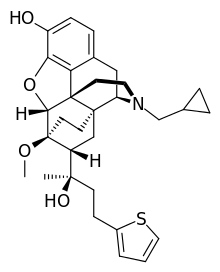Thienorphine
Thienorphine is a very potent, extremely long-acting, orally-active opioid analgesic with mixed agonist–antagonist properties which was developed by the Beijing Institute of Pharmacology and Toxicology as a potential treatment for opioid dependence.[1][2][3] It is a high-affinity, balanced ligand of the μ- (Ki = 0.22 nM), δ- (Ki = 0.69 nM), and κ-opioid receptors (Ki = 0.14 nM), behaving as a partial agonist of the μ- (Emax = 19%–28%) and κ-opioid receptors (Emax = 65–75%) and as an antagonist of the δ-opioid receptor.[4][5][6] It also possesses relatively low affinity for the nociceptin receptor (Ki = 36.5 nM), where it acts as an antagonist.[6]
 | |
| Clinical data | |
|---|---|
| ATC code |
|
| Identifiers | |
IUPAC name
| |
| PubChem CID | |
| ChemSpider | |
| Chemical and physical data | |
| Formula | C31H39NO4S |
| Molar mass | 521.71066 g/mol g·mol−1 |
| 3D model (JSmol) | |
SMILES
| |
InChI
| |
References
- HE Liu, Zhong Bo-Hua, Liu Chun-He, Bo Wu, Gong Ze-Hui (2005). "Synthesis, Crystal Structural and Pharmacological Study of N-Cyclopropylmehtyl-7α-[(R)-1-hydroxyl-1-methyl-3-(thien-2-yl)propyl]-6,14-endoethanotetrahydronooripavine" (PDF). Acta Chimica Slovenica. 52 (1): 80–85. ISSN 1318-0207.CS1 maint: uses authors parameter (link)
- Yu G, Liu YS, Yan LD, Wen Q, Gong ZH (2009). "[Structure-activity relationships analysis of thienorphine and its derivatives]". Yao Xue Xue Bao (in Chinese). 44 (7): 726–30. PMID 19806910.
- Yu, Gang; Li, Shu-Hui; Cui, Meng-Xun; Yan, Ling-Di; Yong, Zheng; Zhou, Pei-Lan; Su, Rui-Bin; Gong, Ze-Hui (2014). "Multiple Mechanisms Underlying the Long Duration of Action of Thienorphine, A Novel Partial Opioid Agonist for the Treatment of Addiction". CNS Neuroscience & Therapeutics. 20 (3): 282–288. doi:10.1111/cns.12210. ISSN 1755-5930. PMC 6492997. PMID 24330593.
- Yu, G. (2006). "Thienorphine Is a Potent Long-Acting Partial Opioid Agonist: A Comparative Study with Buprenorphine". Journal of Pharmacology and Experimental Therapeutics. 318 (1): 282–287. doi:10.1124/jpet.105.099937. ISSN 0022-3565. PMID 16569757.
- Li, J.-X.; Becker, G. L.; Traynor, J. R.; Gong, Z.-H.; France, C. P. (2007). "Thienorphine: Receptor Binding and Behavioral Effects in Rhesus Monkeys". Journal of Pharmacology and Experimental Therapeutics. 321 (1): 227–236. doi:10.1124/jpet.106.113290. ISSN 0022-3565. PMID 17220427.
- Wen, Quan; Yu, Gang; Li, Yu-lei; Yan, Ling-di; Gong, Ze-hui (2011). "Pharmacological mechanisms underlying the antinociceptive and tolerance effects of the 6,14-bridged oripavine compound 030418". Acta Pharmacologica Sinica. 32 (10): 1215–1224. doi:10.1038/aps.2011.83. ISSN 1671-4083. PMC 4010084. PMID 21863064.
This article is issued from
Wikipedia.
The text is licensed under Creative
Commons - Attribution - Sharealike.
Additional terms may apply for the media files.